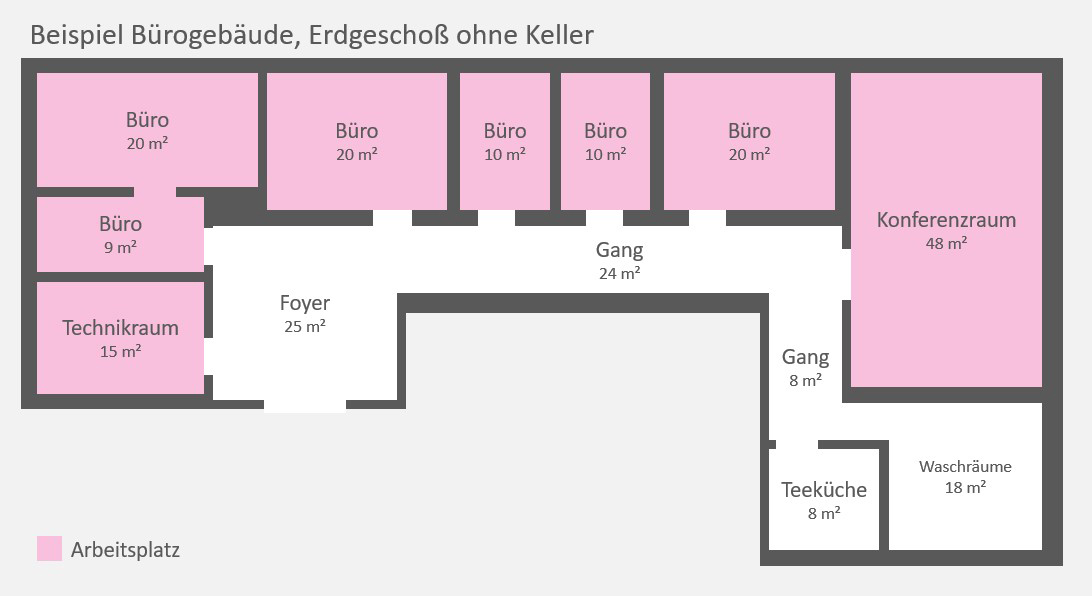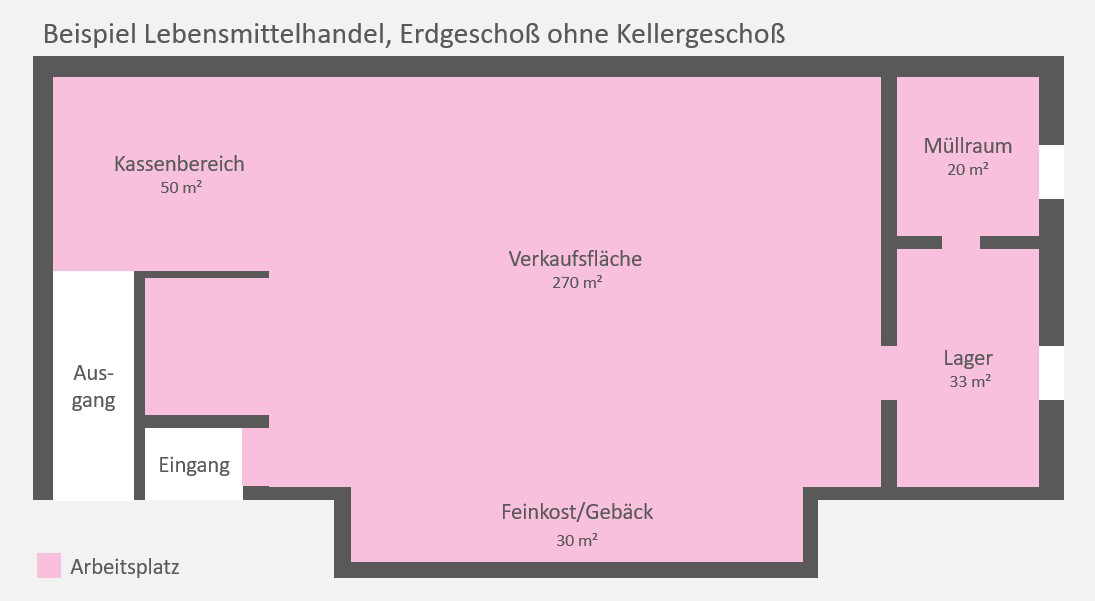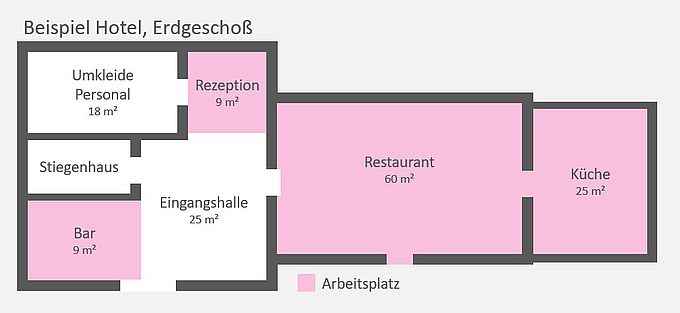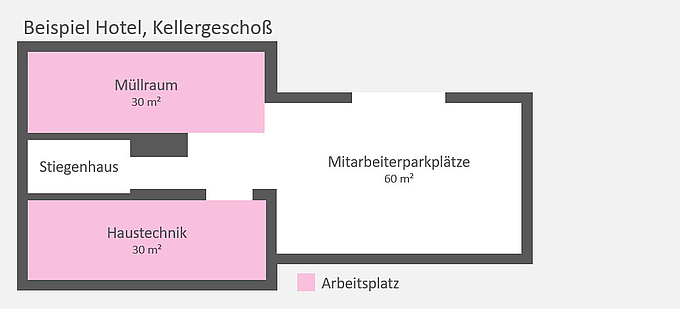Examples of radon measurements in radon protection areas
Due to a new legal obligation, the radon concentration must be determined at workplaces located on the ground floor and in basements in a radon protection area.
The person responsible for the occupational activities carried out at the workplaces commissions an authorized monitoring body for this purpose. The legal provisions can be found in the Radiation Protection Act 2020 (obligation to survey radon exposure) and in the Radon Protection Ordinance. The latter contains many important detailed provisions, such as information to be submitted, prerequisites for exceptions to the determination of radon concentration, and concrete framework conditions for carrying out the measurement, such as time periods.
Guideline "Workplaces in radon protection areas" (PDF, 615 KB)
Note
In order to support the obligated companies, the Federal Ministry for Climate Protection, Environment, Energy, Mobility, Innovation and Technology (BMK) together with the Austrian Federal Economic Chamber (WKO) has published a guide for employers in radon protection areas. This summarizes the most important legal provisions in an easy-to-read form.
Before commissioning the radon measurement
Proceed according to the flow chart (page 17 in the guide "Workplaces in radon protection areas" (PDF, 615 KB)).
Step 1: First clarify whether you are affected by the new obligation. Are there any workplaces in your company for which the survey of radon concentration is mandatory. These are workplaces on the ground floor and in basements in radon protection areas.
Note
The applicable definition of a workplace is important: The workplace in the sense of radon protection is that spatial area in which the employee is present during his/her work. Depending on the task, this can be several areas per person, for example office and meeting room or workshop and warehouse.
Step 2: Then clarify whether one or more conditions for exemptions from the obligation to determine the radon concentration apply to these workplaces. Note that you must notify the competent authority in writing of the exemption if all workplaces meet at least one exemption requirement. To do this, you need a unique site identifier, which you can obtain in edm.gv.at. Instructions for registering and creating sites are available in EDM.
Step 3: For all workplaces for which no exemption requirement applies, you must arrange for the radon concentration to be determined. To do this, you should determine in advance how many workplaces need to be measured and how many radon measurement devices you will need.
The number of radon measuring devices required is basically based on the number of workplaces located on the ground floor and in the basement. Workplaces are to be deducted from this if an exceptional condition is fulfilled for them. In addition, workplaces can be measured together under certain conditions.
- If several workstations are located in a room with a floor area of less than 150 square meters, the measurement of one workstation in this room is sufficient. The result then applies to all workstations in the room concerned.
- In a room with a floor area of more than 150 square meters, it makes sense to divide the room into areas of less than 150 square meters. At least one measurement should then be taken in each of these areas. The result then applies to all workplaces in the area concerned. If such a division is made, it should be documented and retained. In this case, the measuring devices should be placed in areas where the workers spend the longest time.
Example companies
There is no state of the art radon drainage and no permanently forced ventilated basement. In addition, the building components and component transitions in contact with the ground as well as the penetrations and openings through components and component transitions of the building in contact with the ground are not designed against pressing water. Therefore, no conditions apply to exceptions from the measurement obligation that affect the entire building.
In example company 1, there are eight employees who work 20 to 40 hours per week. Workplaces are located in all offices as well as in the conference room and the technical room. In two offices of 20 m² there are two workstations each. There are several workstations in the conference room. No workstations are located in the foyer, hallway, kitchenette, and washrooms.
Required radon measurements:
- In the case described, one radon measurement is required in each of the offices (six radon meters).
- In the conference room and the technical room, the average time of stay is decisive.
- If workers do not spend more than ten hours per week (averaged over one year) in these workplaces, one of the conditions for exemption from the measurement obligation applies.
- If workers spend more than ten hours per week (averaged over one year) in the technical room or conference room, a radon measurement is required in the respective room (one to two radon measuring devices).
Result: Example company 1 requires six to eight radon measurement devices, depending on the length of time workers spend in the conference room and equipment room.
Note: If offices are vacant for a long period of time, for example, because a worker leaves the company and no new worker is hired, the responsible person does not employ a worker at this workplace. In this case, one of the conditions for exemption from the measurement obligation applies.
There is no radon drainage according to the state of the art and no permanently forced-ventilated basement. In addition, the building components and component transitions in contact with the ground as well as the penetrations and openings through components and component transitions of the building in contact with the ground are not designed against pressing water. Therefore, no conditions apply to exceptions from the measurement obligation that affect the entire building.
In the example enterprise 2 there are several workers, who work 20 to 40 hours per week. Workplaces are located in the checkout area and the deli/pastry counter, on the sales floor, in the warehouse and in the garbage room. Different workers work at each of the workstations.
Required Radon Measurements:
- The sales area together with the areas of the cash registers and the delicatessen/pastry counter form one room. The area of the room is 350 m². Therefore, one measurement is not sufficient for all workstations located in this room because the floor area of the room exceeds 150 m².
- If the room is divided into areas of less than 150 m², there are three areas. Therefore, three radon measuring devices are needed. These should now be positioned to take into account, on the one hand, the residence times of the workers and, on the other hand, the division of the room into three areas. Comparatively long residence times of workers result in each case in the area of the cash registers as well as in the delicatessen / pastry distribution. A radon measuring device should therefore be installed in each of these areas. The third radon measuring device should be set up in the area of the sales area, whereby a sensible distance should be kept to the areas of the cash registers and the delicatessen/pastry counter.
- In the warehouse and trash room, the average time spent is critical.
- If workers do not spend more than ten hours a week (averaged over a year) at these workplaces, one of the conditions for exemption from the measurement obligation applies.
- If workers spend more than ten hours per week (averaged over one year) in the warehouse or in the waste room, a radon measurement is required in the respective room (one to two radon measuring devices).
Result: The example company 2 requires three to five radon measuring devices, depending on the duration of stay of the workers in the warehouse and in the garbage room.
The rooms are located on the upper floors and are therefore not subject to the obligations for radon protection in the workplace. They are therefore not considered in the following.
There is no radon drainage according to the state of the art and no permanently forced-ventilated basement. In addition, the building's structural components and component transitions in contact with the ground, as well as the penetrations and penetrations through structural components and component transitions in contact with the ground, are not designed to resist water under pressure. Therefore, no conditions apply to exceptions from the measurement obligation that affect the entire building.
In example enterprise 3, there are several employees who work 20 to 40 hours per week. Workplaces are located in the reception, bar, restaurant, kitchen, building services and garbage room in the basement. Different workers work at each of the workplaces. No workstations are located in the staff locker room, stairwell, and employee parking areas.
Required radon measurements:
- The reception desk forms one room together with the entrance hall and bar. The area of the room is 43 m². Therefore, one measurement is sufficient for all workstations located in this room because the floor area of the room is less than 150 m². It makes sense to place the radon meter in the area where the workers spend the longest time.
- In the restaurant, one measurement is sufficient for all workplaces located in this room, because the floor area of the room is less than 150 m².
- In the kitchen, one measurement is sufficient for all workplaces located in this room, because the floor area of the room is less than 150 m².
- In the room for building services and in the garbage room, the average time of stay is decisive.
- If workers do not spend more than ten hours a week (averaged over a year) at these workplaces, one of the conditions for exemption from the measurement obligation applies.
- If workers spend more than ten hours per week (averaged over one year) in the room for building services or in the waste room, a radon measurement is required in the respective room (one to two radon measuring devices).
Result: The example company 3 requires three to five radon measuring devices, depending on the duration of stay of the workers in the room for building services and in the garbage room.
Note: Even if the employee parking spaces were in a permanently forced-ventilated underground garage, radon measurements would have to be performed in the restaurant and kitchen, since not all workplaces on the ground floor are separated from the underground by a permanently forced-ventilated floor.



